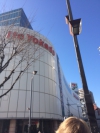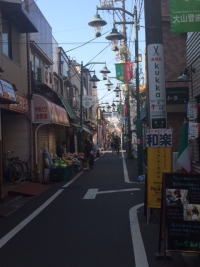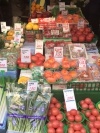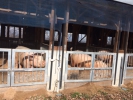Where does this food come from? This is the question that circulates through my mind constantly each day I am in Japan. On our first day when we were asked to think about the statement by Ian Miller, “We are all becoming alienated from our food,” I became curious. The search to discover how true this statement became clearer as I explored several different food markets and department stores. The first stop was at Itoyokado, a big grocery store for the modern citizen in Japan.Immediately walking in the store, the smell of tea brought a smile to my face as it takes me back home and right in front me was a big section of tea. The market took me by surprise when I saw how much food was already made to eat and not a lot of raw food and vegetables that needs more preparation at home. Coming from an Asian background, I was surprised because I have been accustomed to experiencing the Asian food culture with roots in preparing and cooking food as a
became curious. The search to discover how true this statement became clearer as I explored several different food markets and department stores. The first stop was at Itoyokado, a big grocery store for the modern citizen in Japan.Immediately walking in the store, the smell of tea brought a smile to my face as it takes me back home and right in front me was a big section of tea. The market took me by surprise when I saw how much food was already made to eat and not a lot of raw food and vegetables that needs more preparation at home. Coming from an Asian background, I was surprised because I have been accustomed to experiencing the Asian food culture with roots in preparing and cooking food as a  family. The convenience and availability of readily made foods was no different when we stopped at Ikebukuro Station, where we visited both Seibu and Tobu in search of food. I was shocked that there were two huge department stores in a train station and an even bigger food court there. The food court was not like a typical American food court; it consisted of many sit down restaurants where servers and cooks were fast at providing our services. Our order was placed and made before we even sat down at our table. After a day immersed in the culture of a fast paced city in Japan, we traveled to Shiinamachi, where we stopped in Shotengai to explore their shopping district.
family. The convenience and availability of readily made foods was no different when we stopped at Ikebukuro Station, where we visited both Seibu and Tobu in search of food. I was shocked that there were two huge department stores in a train station and an even bigger food court there. The food court was not like a typical American food court; it consisted of many sit down restaurants where servers and cooks were fast at providing our services. Our order was placed and made before we even sat down at our table. After a day immersed in the culture of a fast paced city in Japan, we traveled to Shiinamachi, where we stopped in Shotengai to explore their shopping district.  The environment at Shotengai is pleasantly different than the shops of Itoyokado and Ikebukuro Station. Walking down the quiet streets, you can see parents chas
The environment at Shotengai is pleasantly different than the shops of Itoyokado and Ikebukuro Station. Walking down the quiet streets, you can see parents chas ing their children and customers talking to vendors about the produce they are buying. This interaction is absent in the shops of Itoyokado and Ikebukuro Station. The question I asked myself while looking, smelling, and eating the food products I was buying was, “Where does this come from?” Not once was I able to solidify an answer.
ing their children and customers talking to vendors about the produce they are buying. This interaction is absent in the shops of Itoyokado and Ikebukuro Station. The question I asked myself while looking, smelling, and eating the food products I was buying was, “Where does this come from?” Not once was I able to solidify an answer.
This was very much different when we arrived at the Asian rural institute (ARI), a place where you know exactly what you are eating and how it was produced. ARI is proudly using organic farming as part of their environment. No chemical pesticides are found in their fertilizers; they make their own fertilizer called “bokashi,” a zero chemical fertilizer that contains chicken manure, red soil, rice hull charcoal, rice bran, indigenous microorganisms (IMO), fermented plant juice, and water. Everything they grow, they grow with their own hands and rarely anything is thrown away, so it is reused as something else or compost. ARI’s ideas are simple and innovative for the environment. Instead of using a cemented floor where pigs can stomp on and create a foul smell, they use fermented rice hulls to significantly reduce the smell of manure and urine the pigs produced. The urine and manure then is create into biogas, which can be used for fuel and heating purposes, such as cooking.  This is only a brief knowledge of the first two days I have learned while at ARI and I look forward to learning more about the sustainable things that they have accomplished.
This is only a brief knowledge of the first two days I have learned while at ARI and I look forward to learning more about the sustainable things that they have accomplished.
Food knowledge is the main difference that I see between the people who eat ready-made meals at the big or “modern” grocery stores in Itoyokado and Ikebukuro Station compared to ARI. The convenience of ready available food prepared at the grocery stores inhibits a very important value in life, which is social interaction. People quickly stop in the market to grab something to eat on the go and there is no social relationship that is shared at the table like at ARI. Social interaction is an important part of life, by preparing a meal together, sitting at a table, stories being shared, and relationships are fostered. Being at ARI has made me think more about the food that I eat and the food I choose to buy in the future. Organic farming is life-giving agriculture that uses sustainable technology in hopes of sustaining a healthy future. That is the difference between economically-driven farms that choose to make profit through mass production and organic farming that strives to produce healthy foods in the least harmful ways to sustain all life. The way that ARI makes its own fertilizer and avoids adding chemicals to their soil is a way of sustaining life without causing more harm to ecosystem. In addition, creating a system that rids odor from pig manure and urine to create a biogas that fuels a whole farm is resourceful in not adding additional waste to the environment that could cause more pollution.
ARI’s environmentally conscious methods are important simple solutions to global challenges of pollution.They reuse products to add nutrients to their crops without disruption of the natural order. The natural order, according to Masanobu Fukuoka, who came up with the “do nothing” method of farming, is that the earth cultivates itself naturally by means of the penetration of plant roots and the activity of microorganism, small animals, and earthworms. Nature, stated by Fukuoka, left alone is in perfect balance. This has changed because people believe that they can make something of nature better, but by altering the act of nature, they are making it worse. ARI’s tries to face these global challenges by reverting back to the old ways of farming, before the natural order was disturbed by man. When soil is cultivated, the natural environment is altered beyond recognition. Fukuoka, similar to ARI, makes his own fertilizer and also uses no chemicals. The repercussions of using chemical fertilizer was very well explained by ARI’s own, Osamu. Osamu San explains that when chemicals are added to the soil, the natural microorganisms that exist deep in the soil are killed, this in turns disrupts the natural order. Although plants with chemical fertilizers are bigger or taller, they are not stronger. Because they are growing so fast, they are absorbing only nitrogen from the soils and not enough vitamins. This is a huge misconception for consumers who believe “bigger is better” or healthier, while in reality, it is not. Bigger could easily mean that the product had help from chemical sources and looks to be bigger, but the truth of the matter is, it does not contain more nutrition. The consequences of eating these products could mean eating more chemically made food. It’s easy to forget the source of life, food, when we are driven by the modern technology that provides rapid convenience, but that is not sustainable or always healthy. In a course of two days at ARI, I discovered what it meant to be alienated from our food. We do not stop to consider the question of where our food comes from and how it comes to be. Although while we might never know the origin of the food we eat, we should at least consider the nature of how it was created and what we are putting on our plate. By at least being curious about where our food comes from and how it is grown, we are consciously thinking about ways to make the environment better.

Recent Comments